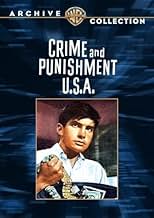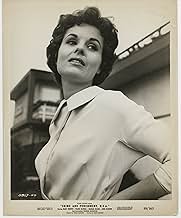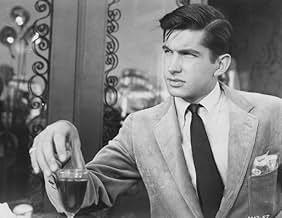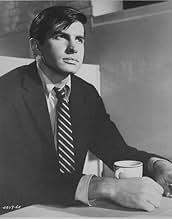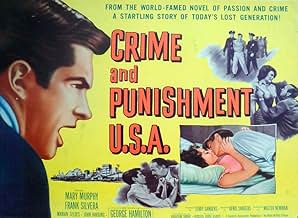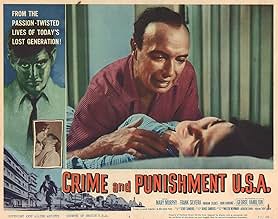CALIFICACIÓN DE IMDb
5.8/10
314
TU CALIFICACIÓN
Agrega una trama en tu idiomaA Californian law student murders a pawnbroker, then matches wits with the detective on the case.A Californian law student murders a pawnbroker, then matches wits with the detective on the case.A Californian law student murders a pawnbroker, then matches wits with the detective on the case.
- Dirección
- Guionistas
- Elenco
- Nominada a1 premio BAFTA
- 2 premios ganados y 1 nominación en total
Tony Johnson
- Mrs. Cole
- (as Toni Merrill)
Sidney Clute
- Doctor
- (as Sid Clute)
James Hyland
- Man in Coffee Shop
- (as Jim Hyland)
- Dirección
- Guionistas
- Todo el elenco y el equipo
- Producción, taquilla y más en IMDbPro
Opiniones destacadas
This is the kind of film, which you wonder how it ever got made, but in a good way. It seems to be the result of either a very low budget or some real out of the box thinking to transfer Dostoyevsky's classic to contemporary Los Angeles. Yet somehow the cinematography showing the seedy underbelly of sunny Southern California is perfectly evocative of the kind of desperation, want and need in the original novel.
George Hamilton, never a very convincing dramatic actor, does well in his first starring role as the murderer who can't resist teasing the inspector who seems to know from the beginning that Hamilton is guilty, in a plot device with another reviewer compared to Colombo. The final dénouement will be well known to readers of the novel or viewers of prior versions of the film.
The supporting cast is uniformly good, especially Frank Silvera as the police inspector and John Harding who plays Hamilton's sister's seducer. The jazz soundtrack adds to the dissonance and confusion of the lead character as he tries to evade discovery, while flirting with it at the same time. The film has a vibe similar to "Odds Against Tomorrow."
Clearly, this film wouldn't be for everybody. But I think that followers of the novel, which is still a great read whether or not, you've read it once or four times, will appreciate that whatever led the producers to transfer the setting to Southern California, and budget considerations or not, did an immense service to the novel by putting it in the glare and scrutiny of a dry, parched, California summer, where, instead of beach and sand and surf, that usually accompanies such scenery, you see desolate parking lots, cheap motels, and urban squalor as background to the characters and their melodramatic conflicts.
I think if you view this movie with an open mind, you will find it as unusual and fascinating as I did. Adaptations like this are rare enough. Of course, we are used to such stories been told on PBS with English actors with British accents playing the lead roles. Here you see that in America, we can update a classic and still keep it fascinating and current.
George Hamilton, never a very convincing dramatic actor, does well in his first starring role as the murderer who can't resist teasing the inspector who seems to know from the beginning that Hamilton is guilty, in a plot device with another reviewer compared to Colombo. The final dénouement will be well known to readers of the novel or viewers of prior versions of the film.
The supporting cast is uniformly good, especially Frank Silvera as the police inspector and John Harding who plays Hamilton's sister's seducer. The jazz soundtrack adds to the dissonance and confusion of the lead character as he tries to evade discovery, while flirting with it at the same time. The film has a vibe similar to "Odds Against Tomorrow."
Clearly, this film wouldn't be for everybody. But I think that followers of the novel, which is still a great read whether or not, you've read it once or four times, will appreciate that whatever led the producers to transfer the setting to Southern California, and budget considerations or not, did an immense service to the novel by putting it in the glare and scrutiny of a dry, parched, California summer, where, instead of beach and sand and surf, that usually accompanies such scenery, you see desolate parking lots, cheap motels, and urban squalor as background to the characters and their melodramatic conflicts.
I think if you view this movie with an open mind, you will find it as unusual and fascinating as I did. Adaptations like this are rare enough. Of course, we are used to such stories been told on PBS with English actors with British accents playing the lead roles. Here you see that in America, we can update a classic and still keep it fascinating and current.
Actually more like the previous years' COMPULSION than a modernization of Fyodor Dostoevsky's CRIME AND PUNISHMENT... although that's exactly what it is, by title, and if Frank Silvera's friendly, complimenting homicide detective is reminiscent of the 1970's TV-cop COLUMBO, both are based on the same literary character...
And ironically, George Hamilton became a victim-of-persuasion from both determined constables and here, resembling Anthony Perkins with the combined personalities of either COMPULSION killer... broodingly into Atheist philosophy while acting too good for everyone, in particular the earthy lawman... he's more aimless than guilt-ridden...
The grainy-B&W Los Angeles-set sequences between Hamilton's Robert and the affable yet clinging detective are no different in tone than existential conversations with deep-thinking heart-of-gold-hooker Mary Murphy, his best buddy (Wayne Heffney) or his sister's middle-aged fiance (seeming straight from an Actor's Studio workshop)... yet the overall stagey aspect's so upfront and natural, CRIME feels more intriguing than meandering...
And while never claiming to be a thriller, it's no melodrama either, fitting within a kind of Beatnik's soulless journey that... between the genuine street thug film noirs and the colorful counter-culture neo noirs... exists within the sharpened jazz-soaked cinema of the late 1950's, as unappreciated now as it was back then.
And ironically, George Hamilton became a victim-of-persuasion from both determined constables and here, resembling Anthony Perkins with the combined personalities of either COMPULSION killer... broodingly into Atheist philosophy while acting too good for everyone, in particular the earthy lawman... he's more aimless than guilt-ridden...
The grainy-B&W Los Angeles-set sequences between Hamilton's Robert and the affable yet clinging detective are no different in tone than existential conversations with deep-thinking heart-of-gold-hooker Mary Murphy, his best buddy (Wayne Heffney) or his sister's middle-aged fiance (seeming straight from an Actor's Studio workshop)... yet the overall stagey aspect's so upfront and natural, CRIME feels more intriguing than meandering...
And while never claiming to be a thriller, it's no melodrama either, fitting within a kind of Beatnik's soulless journey that... between the genuine street thug film noirs and the colorful counter-culture neo noirs... exists within the sharpened jazz-soaked cinema of the late 1950's, as unappreciated now as it was back then.
"Crime & Punishment, USA" updates Fyodor Dostoevsky novel to the 20th century and transports it from Saint Petersburg to Los Angeles. It wasn't the first film to do so, with a 1956 French adaptation and, before that, the American "Fear" (1946) is a "Crime and Punishment" picture in all but name; plus, another 1959 reworking also from France, Robert Bresson's "Pickpocket," took even more liberties with the text that it's, nonetheless, clearly inspired by. I'm not opposed to loose reworkings in the transmutation from prose to picture; indeed, "Pickpocket" is my favorite Dostoevsky film. Especially for a poor production such as this American counterpart, updating and transporting a narrative in adaptation makes a lot of economic sense. Moreover, it may lead to some interesting reinterpretations of the source that make it more relatable to modern times. Asking a low-budget 1959 film to adequately transcribe, say, the criticism of Russian nihilism from Dostoevsky's 19th century is a tall order and equally so for a general 1959 audience to understand. This film acknowledges that; plus, at least, it's evident that the filmmakers comprehended Dostoyevsky's story. Cleverly, they replaced the radicalism of Dostoevsky's era with some from their own--the Beat Generation.
Like Dostoevsky's protagonist Raskolnikov, the film's Robert murders a pawnbroker based on his philosophizing about his own supposed superiority (including in an article he penned), thus allowing him to flaunt the law in pursuit of allegedly benefiting humanity at large. Both characters' beliefs are of the sort of atheistic and counter-cultural order mocked by the conservative Dostoevsky. Thus, we see Robert play the bongos and even tap on his coffee cup before that. He doesn't wear turtlenecks and a fedora like a stereotypical beatnik, but I sense he thinks he's hip smoking a pipe instead of cigarettes like any upstanding 1950s American would. He's also unconcerned when the picture's Sonya type, renamed "Sally," admits her sexual promiscuity, but is upset with her prostitution because it's a self-sacrificing act that goes against his hedonistic thinking. A young George Hamilton looks the part, too. And, to top it off, we get a jazzy score.
I also like what is done with the Svidrigaïlov character, renamed "Fred." He's more vital here to Robert's redemption, unintended as it may be, whereas Sonya's "hooker with a heart of gold" was the underlying force behind that of Raskolnikov. Fortunately, Fred isn't the usual movie heavy as his counterpart was in the 1935 American adaptation, either. In the book, I found him to be one of the more amusing characters, and so he is here. I'm less fond of what is done with Sally. She's also something of a beatnik--what with the book of non-traditional spirituality in her room. She even sleeps with Robert right after he confessed the murder to her. She initially suggests that he turn himself in, but as quickly gives up on the idea. As with other adaptations, time is also given to the inspector interrogating the murderer, which is fairly well done here, although the 1935 French version remains probably my favorite handling of this character dynamic.
Unfortunately, the poor production values also lead to this appearing largely as a filmed play, with characters mostly talking in cramped flats. We don't see too much of Robert's Los Angeles, and he only briefly mentions the sort of wandering throughout the city that Raskolnikov did to consume much of the novel's substantial length. We also don't see the murder. And some of the sound effects are poorly done. Nevertheless, it does that one important thing right in updating its source to the Beat Generation. It's far from the best but also far from the worst version of the book I've seen.
Like Dostoevsky's protagonist Raskolnikov, the film's Robert murders a pawnbroker based on his philosophizing about his own supposed superiority (including in an article he penned), thus allowing him to flaunt the law in pursuit of allegedly benefiting humanity at large. Both characters' beliefs are of the sort of atheistic and counter-cultural order mocked by the conservative Dostoevsky. Thus, we see Robert play the bongos and even tap on his coffee cup before that. He doesn't wear turtlenecks and a fedora like a stereotypical beatnik, but I sense he thinks he's hip smoking a pipe instead of cigarettes like any upstanding 1950s American would. He's also unconcerned when the picture's Sonya type, renamed "Sally," admits her sexual promiscuity, but is upset with her prostitution because it's a self-sacrificing act that goes against his hedonistic thinking. A young George Hamilton looks the part, too. And, to top it off, we get a jazzy score.
I also like what is done with the Svidrigaïlov character, renamed "Fred." He's more vital here to Robert's redemption, unintended as it may be, whereas Sonya's "hooker with a heart of gold" was the underlying force behind that of Raskolnikov. Fortunately, Fred isn't the usual movie heavy as his counterpart was in the 1935 American adaptation, either. In the book, I found him to be one of the more amusing characters, and so he is here. I'm less fond of what is done with Sally. She's also something of a beatnik--what with the book of non-traditional spirituality in her room. She even sleeps with Robert right after he confessed the murder to her. She initially suggests that he turn himself in, but as quickly gives up on the idea. As with other adaptations, time is also given to the inspector interrogating the murderer, which is fairly well done here, although the 1935 French version remains probably my favorite handling of this character dynamic.
Unfortunately, the poor production values also lead to this appearing largely as a filmed play, with characters mostly talking in cramped flats. We don't see too much of Robert's Los Angeles, and he only briefly mentions the sort of wandering throughout the city that Raskolnikov did to consume much of the novel's substantial length. We also don't see the murder. And some of the sound effects are poorly done. Nevertheless, it does that one important thing right in updating its source to the Beat Generation. It's far from the best but also far from the worst version of the book I've seen.
I haven't seen this movie for more years than I care to remember. It was released accompanied by sensationalistic contemporary tag lines -- "Beatniks! Rebels!" -- partly because George Hamilton is seen playing the bongos once in a while. Yet, it has stuck in my memory. It really was an unusual film.
First of all, Dostoyevsky is rather awkwardly superimposed on a story involving residents of modern L.A. The novel doesn't quite fit on the setting. People have serious conversations about God and the afterlife. Okay for a 19th-cntury Rusian novel -- but sunny California? Home of the Fountain of the World Cult?
And it always bothered me about the novel that everyone in Petersberg seems to be acquainted with everyone else. It was a bit difficult to swallow that proposition in the novel; it is absolutely impossible for that to have been true in L.A. circa 1960, the most anomic community on the face of the planet. But instead of being an irritation, the lack of fit between the plot and its contemporary setting lends the film an unquiet, almost surreal quality. Something is off kilter and we don't know exactly what. We squirm with bemusement.
Two points ought to be made. The movie must have been shot on the cheap. In this case, it inadvertently helps. We are given a tour of the seedier sections of L.A. -- railroad tracks, refuse dumps, shabby housing -- that a better-funded film would probably have avoided. Instead of Echo Park we get a slum. This is commonplace now, but it wasn't at the time. It's too bad nobody in California seems to know what a genuine slum looks like. Here it's all a sun-drenched, palm-fronded, flower-strewn paradise, however desecrated. They should have set it in Newark. And they needn't have used high-key lighting so consistently. It looks like an early television sitcom.
Second, the acting is actually quite good. I am even willing to forgive George Hamilton's handsomeness. (He's always been willing to poke fun at himself anyway.) Mary Murphy is not the young naif she played in "The Wild One." She's not exactly a hooker either, as she was in the novel. In 1960 neither audiences nor agents of social control were prepared for that. But she is a serious kind of easy lay, which was still saying a lot. Best of all is Frank Silvera. The smooth admirable way in which he insinuates himself into Robert's life. The cat and mouse repartee. The wondering expression on his face, his amazement that Hamilton has not yet caught on, as he tells him who committed the murder -- "Why YOU did, Robert."
I don't know how I would respond to the movie now, lo, these many years later. But, crude as it is, it's not just a shoddy ripoff of a famous psychological drama. It would be a mistake to think so. If all the elements of the film are amateurish, as in a high school play, the people involved seem to be hitting the right notes by accident. This is worth catching, a real curiosity.
First of all, Dostoyevsky is rather awkwardly superimposed on a story involving residents of modern L.A. The novel doesn't quite fit on the setting. People have serious conversations about God and the afterlife. Okay for a 19th-cntury Rusian novel -- but sunny California? Home of the Fountain of the World Cult?
And it always bothered me about the novel that everyone in Petersberg seems to be acquainted with everyone else. It was a bit difficult to swallow that proposition in the novel; it is absolutely impossible for that to have been true in L.A. circa 1960, the most anomic community on the face of the planet. But instead of being an irritation, the lack of fit between the plot and its contemporary setting lends the film an unquiet, almost surreal quality. Something is off kilter and we don't know exactly what. We squirm with bemusement.
Two points ought to be made. The movie must have been shot on the cheap. In this case, it inadvertently helps. We are given a tour of the seedier sections of L.A. -- railroad tracks, refuse dumps, shabby housing -- that a better-funded film would probably have avoided. Instead of Echo Park we get a slum. This is commonplace now, but it wasn't at the time. It's too bad nobody in California seems to know what a genuine slum looks like. Here it's all a sun-drenched, palm-fronded, flower-strewn paradise, however desecrated. They should have set it in Newark. And they needn't have used high-key lighting so consistently. It looks like an early television sitcom.
Second, the acting is actually quite good. I am even willing to forgive George Hamilton's handsomeness. (He's always been willing to poke fun at himself anyway.) Mary Murphy is not the young naif she played in "The Wild One." She's not exactly a hooker either, as she was in the novel. In 1960 neither audiences nor agents of social control were prepared for that. But she is a serious kind of easy lay, which was still saying a lot. Best of all is Frank Silvera. The smooth admirable way in which he insinuates himself into Robert's life. The cat and mouse repartee. The wondering expression on his face, his amazement that Hamilton has not yet caught on, as he tells him who committed the murder -- "Why YOU did, Robert."
I don't know how I would respond to the movie now, lo, these many years later. But, crude as it is, it's not just a shoddy ripoff of a famous psychological drama. It would be a mistake to think so. If all the elements of the film are amateurish, as in a high school play, the people involved seem to be hitting the right notes by accident. This is worth catching, a real curiosity.
This is a well written script based on Dostoyevsky's "Crime and Punishment." I think it is essentially a remake of a French film, with Jean Gabin,called "Crime and Punishment," later changed to "The Most Dangerous Sin," made around the same time. At any rate, self- justification, remorse, rationalization, guilt, and Truth are the subjects at hand. Each is handled slowly, without emphasis; the viewer is expected to bring much to the picture. This explains the films lower ratings. Hamilton, as an actor, is weak, others have been reminded of Tony Perkins. He was too handsome, and wasn't smart enough to use make up or a cheap haircut to make himself appear to be the poor student of his role. But, the real star is Frank Silvera, who underplays the cagey Detective, and is a joy to watch in action. He toys with Hamilton, who, unfortunately, just isn't his match (as an actor.) Marian Seldes plays Hamilton's long suffering sister.
¿Sabías que…?
- TriviaThe opening aerial shots are of Pacific Ocean Park in Santa Monica, CA, a popular amusement park in the 1960s that has since closed down.
- ConexionesReferenced in Hollywood Mouth 3 (2018)
Selecciones populares
Inicia sesión para calificar y agrega a la lista de videos para obtener recomendaciones personalizadas
Detalles
- Tiempo de ejecución1 hora 36 minutos
- Color
- Mezcla de sonido
Contribuir a esta página
Sugiere una edición o agrega el contenido que falta

Principales brechas de datos
By what name was Confidencias de un asesino (1959) officially released in India in English?
Responda
